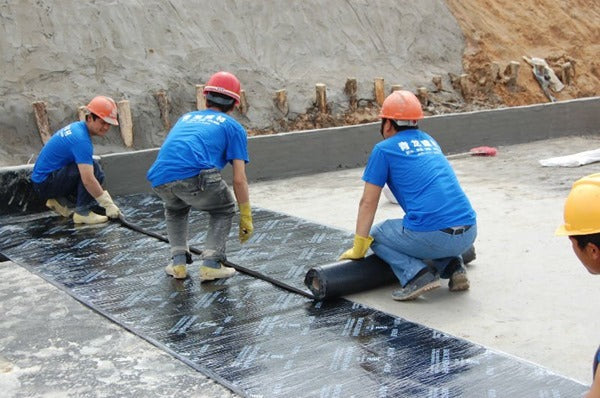
Foundation waterproofing is a technique that prevents water from entering the inside of the basement by applying a protective membrane to the exterior of the foundation wall. It aids in maintaining the interior’s dryness. Without using this technique, water can readily seep through the foundation wall’s fissures.
Nobody wants to return home to a wet or leaky basement, so exercising caution and taking precautions right away is critical. Waterproofing the foundation can help stop mold growth and faults with sump pumps. Since not all basements and their conditions are the same, it is crucial to find a qualified contractor who can provide an all-encompassing solution that will last a very long time. Here are several choices for waterproofing a foundation:
For waterproofing foundations, cement is a relatively accessible and affordable material. It is simple to combine and apply with a brush. The cement can be mixed with an acrylic solution to improve its adhesion to the surface and provide a more robust coating.
The rubber membrane is a powerful and environmentally beneficial method of preventing flooding in your basement. It doesn’t include any harmful materials and doesn’t harm the nearby property. This can seal indoor and external surfaces to keep out moisture, insects, and water. You can spray it on or paint it on.
Tar
To prevent water from entering the basement, thick, sticky tar can be applied to the surface. Using it in layers will stop water from going through.
Bentonite is a substance that resembles clay and can absorb water. When mixed with butyl rubber, it can form a film that permanently seals off openings and prevents water from seeping through cracks in walls. Since it is non-toxic, using and applying it is simple. Additionally, it guards against harm to any adjacent property.
Excavation
A trench or drain is created beneath to stop water from getting into the basement. If done correctly, it is the most effective way.
It is possible to waterproof a foundation from both inside and outside. Depending on the situation, you can choose either an internal or an exterior foundation waterproofing option. A basement can easily be kept dry using waterproofing, drainage, and sealants. Investing in exterior foundation waterproofing is brilliant whether you have a wet basement or are looking for strategies to stop basement flooding.
Your basement can be shielded against flooding with Toronto basement waterproofing. For Toronto foundation waterproofing, use a qualified contractor.
A functional living space that is healthier and dryer is ensured through foundation waterproofing. I have never encountered a wet basement, crawl space, or foundation issue that couldn’t be fixed. Many prefer basements over upstairs areas since they are dry, sterile, and odor-free, thanks to foundation waterproofing.
Waterproofing your foundation is an essential step in keeping your house value and critical defense against very significant damage. Professionals typically carry out foundation waterproofing, which is not generally suggested as a DIY project.
A house’s foundation should be waterproofed before construction can begin. To have peace of mind for many years, foundation waterproofing should be taken care of before any property is completed. Due to leaking basements, hundreds of people lose thousands of dollars each year when selling their homes. Sometimes, and I mean occasionally, the issue may be resolved by adding more earth to the area around your foundation.
Water infiltration through the foundation is successfully stopped by foundation waterproofing systems, which are applied externally to the foundation walls. Although foundation waterproofing is costly and time-consuming, if done correctly, moist basement walls and flooring are typically a thing of the past.
Over the foundation, you can paint an emulsified tar solution and apply asphalt felt. Dampproofing and foundation waterproofing are frequently mistaken terms. Water entry into foundations is delayed or slowed down through damp proofing. Typically, foundation surfaces are coated with unaltered asphalt to prevent dampness.
You can use waterproofing felt or fabric that has been coal-tar pitch treated to coat basement walls. This effectively prevents seepage by acting as a barrier. Starting from outside your house, waterproof your basement. Keep an eye out for locations near your foundation where water tends to collect.
Basement wall cracks must be addressed continuously because they will continue to worsen as they expand and contract in response to changes in temperature and moisture. This article examines the benefits and drawbacks of DIY fixes and outside waterproofing while providing a spot for basement wall cracks.
Because basements are enclosed spaces, they are vulnerable to high humidity levels that cause flooding and moisture. Depending on the conditions, you can have structural damage from rot or early paint failure. There are several possible causes for basement leaks. Check for leaks in your downspouts and gutters, and confirm that the ground is sloped away from the foundation. Many things can cause basements to leak. Regular basement moisture can make it easier for wood boring insects and structural rot to spread.
Many things can cause basements to leak. Some foundation waterproofing techniques are do-it-yourself projects. Numerous factors might cause basements to overflow. Installing sump pumps is one of the fundamental methods of waterproofing a foundation.
Waterproofing for foundations prevents water seepage by withstanding water and freeze-thaw cycles. Neither you nor your builders will have to worry about callbacks or wet basement issues. J-Cote foundation waterproofing prevents water seepage by resisting moisture and freeze-thaw processes. Mold and other moister problems resulting from an incorrectly or inadequately waterproofed foundation are less likely to occur in a dry basement.
Always research potential contractors to locate the right one for the task. The cheapest option is not usually the greatest; therefore, if you base your choice on price, you should be prepared to be disappointed most of the time.







